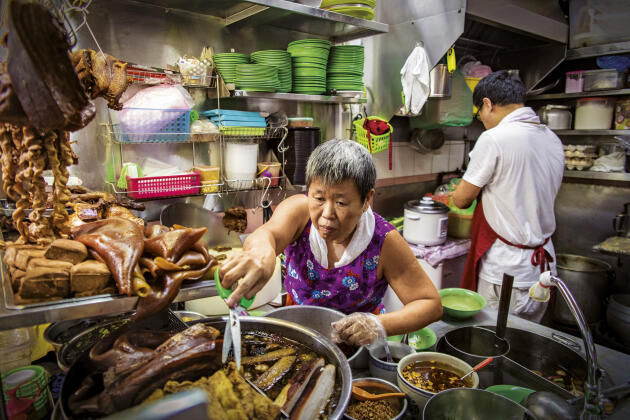A Victorian legacy of the British presence in Singapore, the eight star-shaped aisles in the octagonal hall of Lau Pa Sat are teeming with delicacies. Under the fan blades trying to ventilate the equatorial heat, families, students and tourists crowd past more than a hundred stands, before sitting down at one of the many tables that dot the galleries.
Glowing amber of ducks and pork belly, woks where the nasi goreng (Indonesian fried rice), bowls of soup overflowing with pork ribs or seafood, sweet smell of beef rendangthis Malaysian beef stew with sweet spices… Under the large, garishly colored signs, the stalls embody the melting pot of the city-state.
If four official languages are spoken (English, Mandarin, Malay and Tamil) and more than ten religions practiced, appetites are also polyglot and multi-faith. In the United States, we would call the place a food court, in France, a “food court”. In Singapore, the appetite vibrates to the rhythm of what we call hawker centers.
Lau Pa Sat is one of these approximately one hundred and twenty “ centers » what does the city have? In the evening, the frenzy spills over onto the sidewalk, to the point that at the foot of the market, Boon Tat Street transforms into satay street. Clouds of smoke escape from the Malaysian barbecues on which grilling, in mode satay, thousands of small skewers of beef, lamb, chicken or shrimp (sold for around 50 euro cents each). Marinated in a mixture of lemongrass, garlic, shallots, ginger and fresh turmeric, palm sugar, chili pepper, coriander and cumin powder, they then caramelize on the embers, before being served , accompanied by a thick sauce made from tamarind, coconut milk and roasted peanuts. Once devoured, all that remains is a pile of spikes, like a dirty game of Mikado.
Those who only have the image of Singapore as a sanitized financial center would be surprised by the sensual profusion and the mix offered by these hawkers centerspopular with foodies international. Installed in the heart of vintage buildings or ultra-modern air-conditioned buildings, these areas, and their culinary practices, were included in 2020 by UNESCO on the representative list of the Intangible Cultural Heritage of Humanity.
The expression “hawker center” is almost an oxymoron. In fact, it evokes the sedentarization of traditional street vendors (hawkers). Their numbers increased after 1819, when Sir Thomas Stamford Raffles took possession of the Malay island of Singapura for England. The rapid expansion of this trading post led to the massive arrival of a workforce mainly from southern China and India. First carrying bamboo baskets then pushing carts, the hawkers fed this working mass by offering snacks adapted to their regional traditions.
You have 70% of this article left to read. The rest is reserved for subscribers.
